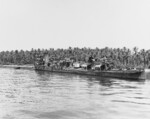Nagatsuki
| Country | Japan |
| Ship Class | Mutsuki-class Destroyer |
| Builder | Tokyo |
| Launched | 1 Apr 1927 |
| Sunk | 6 Jul 1943 |
| Displacement | 1,315 tons standard |
Contributor: C. Peter Chen
ww2dbaseNagatsuki, a 1315-ton Mutsuki class destroyer built at Tokyo, Japan, was completed as (Destroyer) Number 30 in April 1927. She was renamed Nagatsuki in 1928. In the years before World War II she participated in the normal activities of the Japanese fleet, including the realistic exercises that gave that navy a high degree of readiness for night combat.
ww2dbaseOn 10 December 1941, a few days after the Pacific War began, Nagatsuki participated in the landings at Aparri, at the northern end of Luzon. Later in the month, she took part in the main invasion of Luzon, at Lingayen, and was lightly damaged by an air attack at that time. During the East Indies Campaign, in the first months of 1942, she was part of the force that put troops ashore in western Java, and in early April assisted the cruiser Naka after that ship had been torpedoed by a U.S. submarine.
ww2dbaseIn early February 1943 Nagatsuki assisted with the evacuation of Guadalcanal, which brought an end to the long and bitter Guadalcanal campaign. In the war's next phase, the fight for the Central Solomons, she served as a fast transport, bringing troops to threatened Japanese bases. While so employed on the night of 5-6 July 1943, Nagatsuki was badly damaged by U.S. warship gunfire in the Battle of Kula Gulf. At the close of that action, she was grounded north of Vila. After her forward ammunition blew up when she was bombed on the morning and afternoon of 6 July, Nagatsuki was abandoned where she lay, just off the shore of Kolombangara Island.
ww2dbaseSource:
US Navy Naval History and Heritage Command
Last Major Revision: Jan 2005
Destroyer Nagatsuki Interactive Map
Photographs
 |  |
Nagatsuki Operational Timeline
| 5 Jul 1943 | The US Northern Landing Group under Colonel Harry Liversedge landed at Rice Anchorage on the northern coast of New Georgia, Solomon Islands. On the same day shortly after midnight, US cruisers USS Honolulu, USS Helena, and USS St. Louis escorted by destroyers USS Nicholas, USS Strong, USS Chevalier, and USS O’Bannon entered Kula Gulf to shell Japanese positions on Kolombangara and New Georgia in support of the landings at Rice Anchorage. At the same time, Japanese destroyers Niizuki, Nagatsuki, Yunagi, and Satsuki arrived at the north end of Kula Gulf loaded with 1,300 reinforcement troops and 180 tons of provisions bound for Vila, Kolombangara at the south end of Kula Gulf. Upon the commencement of the American shelling at Bairoka Harbor, New Georgia, the Japanese commander, Commander Kunizo Kanaoka, aborted the mission and ordered a withdrawal. As they turned, Niizuki, Nagatsuki, and Yunagi launched a spread of 14 Type 93 “Long Lance” torpedoes into the gulf. At a range of 22,000 yards (11 nautical miles), one of the torpedoes struck and sank destroyer USS Strong. This is believed to be the longest successful torpedo attack of the war. The Americans never detected the presence of the Japanese destroyers and believed Strong was torpedoed by a submarine. |
Você gostou deste artigo ou achou este artigo útil? Se sim, considere nos apoiar no Patreon. Mesmo USD $1 por mês já vai longe! Obrigado. Por favor, ajude-nos a espalhar a palavra: Fique atualizado com WW2DB: |
Visitor Submitted Comments
All visitor submitted comments are opinions of those making the submissions and do not reflect views of WW2DB.

» Guadalcanal Campaign
Partner Sites Content:
» Nagatsuki Tabular Record of Movement
- » 1,171 biographies
- » 337 events
- » 44,911 timeline entries
- » 1,245 ships
- » 350 aircraft models
- » 207 vehicle models
- » 376 weapon models
- » 123 historical documents
- » 261 facilities
- » 470 book reviews
- » 28,521 photos
- » 365 maps
Winston Churchill, on the RAF
Por favor, considere nos apoiar no Patreon. Mesmo R$1 por mês já faz uma grande diferença. Obrigado!
Ou, por favor, nos apoie adquirindo alguns produtos do WW2DB na TeeSpring. Obrigado!
22 Apr 2024 04:27:12 PM
The wrecks of the Mutsuki-class destroyers that were grounded during the Solomons campaign had long since disappeared, as was the case with Mikazuki, having broken up and sank years after she was abandoned. Nagatsuki, as some claim, had been freed by the tides and foundered away from shore. As of now, only Kikuzuki remains barely visible, with her entire superstructure removed. The last visit to her wreck was made by a restoration society, which removed her No. 4 main gun for display in Maizuru, Japan.